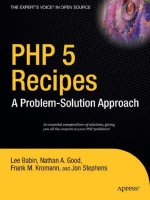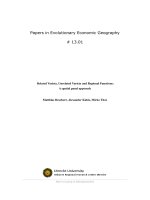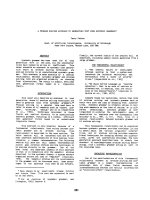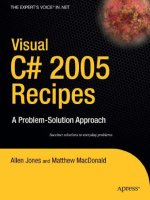measure probability and mathematical finance a problem oriented approach pdf
Bạn đang xem bản rút gọn của tài liệu. Xem và tải ngay bản đầy đủ của tài liệu tại đây (19.88 MB, 741 trang )
www.TechnicalBooksPDF.com
MEASURE, PROBABILITY,
AND MATHEMATICAL
FINANCE
www.TechnicalBooksPDF.com
www.TechnicalBooksPDF.com
MEASURE, PROBABILITY,
AND MATHEMATICAL
FINANCE
A Problem-Oriented Approach
Guojun Gan
Manulife Financial
Toronto, ON, Canada
Chaoqun Ma
School of Business Administration
Hunan University
Changsha, Hunan, P.R. China
HongXie
Manulife Financial
Toronto, ON, Canada
WILEY
www.TechnicalBooksPDF.com
Copyright© 2014 by John Wiley & Sons, Inc. All rights reserved.
Published by John Wiley & Sons, Inc., Hoboken, New Jersey.
Published simultaneously in Canada.
No part of this publication may be reproduced, stored in a retrieval system or transmitted in any form or
by any means, electronic, mechanical, photocopying, recording, scanning or otherwise, except as
permitted under Section I 07 or I 08 of the 1976 United States Copyright Act, without either the prior
written permission of the Publisher, or authorization through payment of the appropriate per-copy fee to
the Copyright Clearance Center, Inc., 222 Rosewood Drive, Danvers, MA 01923, (978) 750-8400, fax
(978) 750-4470, or on the web at www.copyright.com. Requests to the Publisher for permission should
be addressed to the Permissions Department, John Wiley & Sons, Inc., Ill River Street, Hoboken, NJ
07030, (201) 748-60 II, fax (201) 748-6008, or online at />Limit of Liability/Disclaimer of Warranty: While the publisher and author have used their best efforts in
preparing this book, they make no representation or warranties with respect to the accuracy or
completeness of the contents of this book and specifically disclaim any implied warranties of
merchantability or fitness for a particular purpose. No warranty may be created or extended by sales
representatives or written sales materials. The advice and strategies contained herein may not be suitable
for your situation. You should consult with a professional where appropriate. Neither the publisher nor
author shall be liable for any loss of profit or any other commercial damages, including but not limited
to special, incidental, consequential, or other damages.
For general information on our other products and services please contact our Customer Care
Department within the United States at (800) 762-2974, outside the United States at (317) 572-3993 or
fax (317) 572-4002.
Wiley also publishes its books in a variety of electronic formats. Some content that appears in print,
however, may not be available in electronic formats. For more information about Wiley products, visit
our web site at www.wiley.com.
Library of Congress Cataloging-in-Publication Data is available.
Measure, Probability, and Mathematical Finance: A Problem-Oriented Approach
Guojun Gan, Chaoqun Ma, and Hong Xie
ISBN 978-1-118-83196-0
Printed in the United States of America.
10 9 8 7 6 5 4 3 2 I
www.TechnicalBooksPDF.com
To my parents
-Guojun Gan
To my wife and my
daughter
-ChaoqunMa
To my family and
friends
-Hong Xie
www.TechnicalBooksPDF.com
www.TechnicalBooksPDF.com
CONTENTS
Preface
XVll
Financial Glossary
xxii
PART I
1
Sets and Sequences
1.1
1.2
1.3
1.4
1.5
2
MEASURE THEORY
3
Basic Concepts and Facts
3
Problems
Hints
6
Solutions
Bibliographic Notes
8
8
13
Measures
15
2.1
Basic Concepts and Facts
Problems
15
2.2
2.3
Hints
20
2.4
Solutions
21
18
vii
www.TechnicalBooksPDF.com
viii
CONTENTS
2.5
3
4
5
6
7
8
Bibliographic Notes
28
Extension of Measures
29
3.1
3.2
3.3
3.4
3.5
29
30
32
32
36
Basic Concepts and Facts
Problems
Hints
Solutions
Bibliographic Notes
Lebesgue-Stieltjes Measures
37
4.1
4.2
4.3
4.4
4.5
37
39
41
41
45
Basic Concepts and Facts
Problems
Hints
Solutions
Bibliographic Notes
Measurable Functions
47
5.1
5.2
5.3
5.4
5.5
47
48
50
51
56
Basic Concepts and Facts
Problems
Hints
Solutions
Bibliographic Notes
Lebesgue Integration
57
6.1
6.2
6.3
6.4
6.5
57
59
62
Basic Concepts and Facts
Problems
Hints
Solutions
Bibliographic Notes
64
76
The Radon-Nikodym Theorem
77
7.1
7.2
7.3
7.4
7.5
77
Basic Concepts and Facts
Problems
Hints
Solutions
Bibliographic Notes
79
80
80
83
85
LP Spaces
www.TechnicalBooksPDF.com
CONTENTS
8.1
8.2
8.3
8.4
8.5
9
10
Basic Concepts and Facts
Problems
Hints
Solutions
Bibliographic Notes
12
13
85
88
89
90
95
Convergence
97
9.1
9.2
9.3
9.4
9.5
97
98
100
102
111
Basic Concepts and Facts
Problems
Hints
Solutions
Bibliographic Notes
Product Measures
113
10.1
10.2
10.3
10.4
10.5
113
115
118
118
123
Basic Concepts and Facts
Problems
Hints
Solutions
Bibliographic Notes
PART II
11
ix
PROBABILITY THEORY
Events and Random Variables
127
11.1
11.2
11.3
11.4
11.5
127
130
132
133
139
Basic Concepts and Facts
Problems
Hints
Solutions
Bibliographic Notes
Independence
141
12.1
12.2
12.3
12.4
12.5
141
142
145
146
159
Basic Concepts and Facts
Problems
Hints
Solutions
Bibliographic Notes
Expectation
161
13.1
161
Basic Concepts and Facts
www.TechnicalBooksPDF.com
X
14
15
16
CONTENTS
13.2
Problems
163
13.3
13.4
Hints
Solutions
165
166
13.5
Bibliographic Notes
172
Conditional Expectation
173
14.1
Basic Concepts and Facts
14.2
14.3
14.4
14.5
Problems
Hints
Solutions
Bibliographic Notes
173
175
178
179
187
Inequalities
189
15.1
15.2
15.3
15.4
15.5
189
190
18
191
192
198
Law of Large Numbers
199
16.1
16.2
Basic Concepts and Facts
199
Problems
Hints
Solutions
Bibliographic Notes
200
203
205
215
16.3
16.4
16.5
17
Basic Concepts and Facts
Problems
Hints
Solutions
Bibliographic Notes
Characteristic Functions
217
17.1
17.2
17.3
17.4
17.5
217
218
220
221
226
Basic Concepts and Facts
Problems
Hints
Solutions
Bibliographic Notes
Discrete Distributions
227
18.1
18.2
Basic Concepts and Facts
Problems
18.3
18.4
Hints
Solutions
227
228
230
231
www.TechnicalBooksPDF.com
CONTENTS
18.5
19
Continuous Distributions
19.1
19.2
19.3
19.4
19.5
20
Bibliographic Notes
Basic Concepts and Facts
Problems
Hints
Solutions
Bibliographic Notes
22
23
237
239
239
241
244
246
256
Central Limit Theorems
257
20.1
20.2
20.3
20.4
20.5
257
258
260
261
267
Basic Concepts and Facts
Problems
Hints
Solutions
Bibliographic Notes
PART Ill
21
xi
STOCHASTIC PROCESSES
Stochastic Processes
271
21.1
21.2
21.3
21.4
21.5
271
275
278
280
289
Basic Concepts and Facts
Problems
Hints
Solutions
Bibliographic Notes
Martingales
291
22.1
22.2
22.3
22.4
22.5
291
292
294
295
300
Basic Concepts and Facts
Problems
Hints
Solutions
Bibliographic Notes
Stopping Times
301
23.1
23.2
23.3
23.4
23.5
301
303
305
307
319
Basic Concepts and Facts
Problems
Hints
Solutions
Bibliographic Notes
www.TechnicalBooksPDF.com
xii
24
CONTENTS
Martingale Inequalities
321
24.1
24.2
24.3
Basic Concepts and Facts
Problems
Hints
Solutions
Bibliographic Notes
321
322
323
324
331
Martingale Convergence Theorems
333
25.1
25.2
25.3
25.4
25.5
333
334
336
336
342
24.4
24.5
25
26
27
28
Random Walks
343
26.1
26.2
26.3
26.4
26.5
343
344
346
347
355
Basic Concepts and Facts
Problems
Hints
Solutions
Bibliographic Notes
Poisson Processes
357
27.1
27.2
27.3
27.4
27.5
357
359
361
361
Basic Concepts and Facts
Problems
Hints
Solutions
Bibliographic Notes
371
Brownian Motion
373
28.1
28.2
28.3
28.4
373
375
377
378
387
28.5
29
Basic Concepts and Facts
Problems
Hints
Solutions
Bibliographic Notes
Basic Concepts and Facts
Problems
Hints
Solutions
Bibliographic Notes
Markov Processes
389
29.1
389
391
29.2
Basic Concepts and Facts
Problems
www.TechnicalBooksPDF.com
CONTENTS
29.3
29.4
29.5
30
Hints
Solutions
Bibliographic Notes
32
401
30.1
30.2
30.3
30.4
30.5
401
404
407
408
417
Basic Concepts and Facts
Problems
Hints
Solutions
Bibliographic Notes
34
STOCHASTIC CALCULUS
The Wiener Integral
421
31.1
31.2
31.3
31.4
31.5
421
423
424
425
429
Basic Concepts and Facts
Problems
Hints
Solutions
Bibliographic Notes
The Ito Integral
431
Basic Concepts and Facts
Problems
Hints
Solutions
Bibliographic Notes
431
433
437
438
452
Extension of the Ito Integral
453
33.1
33.2
33.3
33.4
33.5
453
455
456
457
462
32.1
32.2
32.3
32.4
32.5
33
393
394
399
Levy Processes
PART IV
31
xiii
Basic Concepts and Facts
Problems
Hints
Solutions
Bibliographic Notes
Martingale Stochastic Integrals
463
34.1
34.2
34.3
463
468
469
Basic Concepts and Facts
Problems
Hints
www.TechnicalBooksPDF.com
xiv
CONTENTS
34.4
34.5
35
36
477
35.1
35.2
35.3
35.4
35.5
477
481
483
485
494
39
40
Basic Concepts and Facts
Problems
Hints
Solutions
Bibliographic Notes
Martingale Representation Theorem
Basic Concepts and Facts
Problems
Hints
Solutions
Bibliographic Notes
Change of Measure
37.1
37.2
37.3
37.4
37.5
38
470
475
The Ito Formula
36.1
36.2
36.3
36.4
36.5
37
Solutions
Bibliographic Notes
Basic Concepts and Facts
Problems
Hints
Solutions
Bibliographic Notes
495
495
496
497
498
501
503
503
504
508
508
513
Stochastic Differential Equations
515
38.1
38.2
38.3
38.4
38.5
515
517
521
522
530
Basic Concepts and Facts
Problems
Hints
Solutions
Bibliographic Notes
Diffusion
531
39.1
39.2
39.3
39.4
39.5
531
534
536
537
545
Basic Concepts and Facts
Problems
Hints
Solutions
Bibliographic Notes
The Feynman-Kac Formula
www.TechnicalBooksPDF.com
547
CONTENTS
40.1
40.2
40.3
40.4
40.5
Basic Concepts and Facts
Problems
Hints
Solutions
Bibliographic Notes
PART V
41
42
43
44
45
XV
547
549
551
552
557
STOCHASTIC FINANCIAL MODELS
Discrete-Time Models
561
41.1
41.2
41.3
41.4
41.5
561
565
568
569
576
Basic Concepts and Facts
Problems
Hints
Solutions
Bibliographic Notes
Black-Scholes Option Pricing Models
579
42.1
42.2
42.3
42.4
42.5
579
583
585
586
591
Basic Concepts and Facts
Problems
Hints
Solutions
Bibliographic Notes
Path-Dependent Options
593
43.1
43.2
43.3
43.4
43.5
593
598
600
601
608
Basic Concepts and Facts
Problems
Hints
Solutions
Bibliographic Notes
American Options
609
44.1
44.2
44.3
44.4
44.5
609
613
616
617
626
Basic Concepts and Facts
Problems
Hints
Solutions
Bibliographic Notes
Short Rate Models
629
45.1
629
Basic Concepts and Facts
www.TechnicalBooksPDF.com
xvi
CONTENTS
45.2
45.3
45.4
45.5
46
47
Problems
Hints
Solutions
Bibliographic Notes
631
635
635
644
Instantaneous Forward Rate Models
647
46.1
46.2
46.3
46.4
46.5
647
650
654
654
665
Basic Concepts and Facts
Problems
Hints
Solutions
Bibliographic Notes
LIBOR Market Models
667
47.1
47.2
47.3
47.4
47.5
667
668
672
673
685
Basic Concepts and Facts
Problems
Hints
Solutions
Bibliographic Notes
References
687
List of Symbols
703
Subject Index
707
www.TechnicalBooksPDF.com
PREFACE
Mathematical finance, a new branch of mathematics concerned with financial markets, is experiencing rapid growth. During the last three decades, many books and
papers in the area of mathematical finance have been published. However, understanding the literature requires that the reader have a good background in measuretheoretic probability, stochastic processes, and stochastic calculus. The purpose of
this book is to provide the reader with an introduction to the mathematical theory
underlying the financial models being used and developed on Wall Street. To this
end, this book covers important concepts and results in measure theory, probability theory, stochastic processes, and stochastic calculus so that the reader will be in
a position to understand these financial models. Problems as well as solutions are
included to help the reader learn the concepts and results quickly.
In this book, we adopted the definitions and theorems from various books and
presented them in a mathematically rigorous way. We tried to cover the most of the
basic concepts and the important theorems. We selected the problems in this book
in such a way that the problems will help readers understand and know how to apply
the concepts and theorems. This book includes 516 problems, most of which are not
difficult and can be solved by applying the definitions, theorems, and the results of
previous problems.
This book is organized into five parts, each of which is further organized into several chapters. Each chapter is divided into five sections. The first section presents
xvii
www.TechnicalBooksPDF.com
XViii
PREFACE
the definitions of important concepts and theorems. The second, third, and fourth
sections present the problems, hints on how to solve the problems, and the full solutions to the problems, respectively. The last section contains bibliographic notes.
Interdependencies between all chapters are shown in Table 0.1.
Table 0.1: Interdependencies between Chapters.
Chapter
Related to Chapter(s)
I. Sets and Sequences
2. Measures
3. Extension of Measures
1;2
4. Lebesgue-Stieltjes Measures
2;3
5. Measurable Functions
2
6. Lebesgue Integration
1;2;5
7. The Radon-Nikodym Theorem
2;6
8. LP Spaces
2;6
9. Convergence
1;2;6;8
10. Product Measures
2;3;5;6
11. Events and Random Variables
1;2;4;5
12. Independence
2;3;5;11
13. Expectation
2;6;8;10;11;12
14. Conditional Expectation
1;2;5;6;7;8;10;11; 12;13
15. Inequalities
8;11;14
16. Law of Large Numbers
2;8;9;1 0; 12; 13; 15
17. Characteristic Functions
5;6;8;11 ;12;13; 15
18. Discrete Distributions
12;14;17
19. Continuous Distributions
6;10;12;13;17
20. Central Limit Theorems
6;9; II
21. Stochastic Processes
2;5;10;11;12;19
22. Martingales
2;5;11;13;14;15
23. Stopping Times
2;5;9; 11; 14;21 ;22
24. Martingale Inequalities
2;6;8; 13;14;15;23
25. Martingale Convergence Theorems
1;6;9; 11; 14; 15;22
26. Random Walks
8;9; 13; 14; 15; 19;20;22;23;24
27. Poisson Processes
11; 12; 14; 17;21 ;22
28. Brownian Motion
8;9; 11; 12; 14; 15; 16; 17; 19
www.TechnicalBooksPDF.com
PREFACE
XiX
29. Markov Processes
2;6;11;14;21
30. Levy Processes
1;5;6;11 ;12;14;17;19;22;27;28;29
31. The Wiener Integral
6;9;15;19;28
32. The Ito Integral
5;6;8;10;14;15;22;24;28
33. Extension of the Ito Integrals
9; 10; 14;22;23;32
34. Martingale Stochastic Integrals
14;15;19;27;32
35. The Ito Formula
6;8;9;22;24;32;34
36. Martingale Representation Theorem
9; 14;25 ;28;32;33 ;35
37. Change of Measure
7; 14;32;34;35
38. Stochastic Differential Equations
8;11;13;32;34;35
39. Diffusion
6;9; 11; 14; 19;21 ;24;32;35 ;38
40. The Feynman-Kac Formula
6; 14;32;35;38;39
41. Discrete-Time Models
7;12;14;22;23
42. Black-Scholes Option Pricing Models
9; 14; 19;24;32;33;35;36;37 ;38;41
43. Path-Dependent Options
10;14;19;28;37;38;42
44. American Options
14; 15 ;21 ;22;23;32;35 ;36;37 ;42;43
45. Short Rate Models
11;14;19;29;32;35;37;38;39;40
46. Instantaneous Forward Rate Models
10; 14; 19;32;34;35;37 ;38;40;45
47. LIBOR Market Models
14;32;37;45;46
In Part I, we present measure theory, which is indispensable to the rigorous development of probability theory. Measure theory is also necessary for us to discuss
recently developed theories and models in finance, such as the martingale measures,
the change of numeraire theory, and the London interbank offered rate (LIBOR)
market models.
In Part II, we present probability theory in a measure-theoretic mathematical
framework, which was introduced by A.N. Kolmogorov in 1937 in order to deal
with David Hilbert's sixth problem. The material presented in this part was selected
to facilitate the development of stochastic processes in Part III.
In Part III, we present stochastic processes, which include martingales and Brownian motion. In Part IV, we discuss stochastic calculus. Both stochastic processes
and stochastic calculus are important to modem mathematical finance as they are
used to model asset prices and develop derivative pricing models.
In Part V, we present some classic models in mathematical finance. Many pricing
models have been developed and published since the seminal work of Black and
Scholes. This part covers only a small portion of many models.
In this book, we tried to use a uniform set of symbols and notation. For example,
we used N, R, and 0 to denote the set of natural numbers (i.e., nonnegative integers),
www.TechnicalBooksPDF.com
XX
PREFACE
the set of real numbers, and the empty set, respectively. A comprehensive list of
symbols is also provided at the end of this book.
We have taken great pains to ensure the accuracy of the formulas and statements
in this book. However, a few errors are inevitable in almost every book of this size.
Please feel free to contact us if you spot errors or have any other constructive suggestions.
How to Use This Book
This book can be used by individuals in various ways:
(a) It can be used as a self-study book on mathematical finance. The prerequisite is
linear algebra and calculus at the undergraduate level. This book will provide
you with a series of concepts, facts, and problems. You should explore each
problem and write out your solution in such a way that it can be shared with
others. By doing this you will be able to actively develop an in-depth and comprehensive understanding of the concepts and principles that cannot be archived
by passively reading or listening to comments of others.
(b) It can be used as a reference book. This book contains the most important
concepts and theorems from mathematical finance. The reader can find the
definition of a concept or the statement of a theorem in the book through the
index at the end of this book.
(c) It can be used as a supplementary book for individuals who take advanced
courses in mathematical finance. This book starts with measure theory and
builds up to stochastic financial models. It provides necessary prerequisites for
students who take advanced courses in mathematical finance without completing background courses.
Acknowledgments
We would like to thank all the academics and practitioners who have contributed to
the knowledge of mathematical finance. In particular, we would like to thank the
following academics and practitioners whose work constitutes the backbone of this
book: Robert B. Ash, Krishna B. Athreya, Rabi Bhattacharya, Patrick Billingsley,
Tomas Bjork, Fischer Sheffey Black, Kai Lai Chung, Erhan <;:inlar, Catherine A.
Doleans-Dade, Darrell Duffie, Richard Durrett, Robert J. Elliott, Damir Filipovic,
Allan Gut, John Hull, Ioannis Karatzas, Fima C. Klebaner, P. Ekkehard Kopp, HuiHsiung Kuo, Soumendra N. Lahiri, Damien Lamberton, Bernard Lapeyre, Gregory
F. Lawler, Robert C. Merton, Marek Musiela, Bernt Oksendal, Andrea Pascucci,
Jeffrey S. Rosenthal, Sheldon M. Ross, Marek Rutkowski, Myron Scholes, Steven
Shreve, J. Michael Steele, and Edward C. Waymire.
We are grateful to Roman Naryshkin and several anonymous reviewers for their
helpful comments. Guojun Gan and Hong Xie would like to thank their friends
www.TechnicalBooksPDF.com
PREFACE
XXi
and colleagues at the Global Variable Annuity Hedging Department of Manulife
Financial for the pleasant cooperation over the last 4 years.
Guojun Gan gratefully acknowledges support from the CAIS (Canadian Academy
of Independent Scholars) grant and thanks Simon Fraser University for giving him
full access to its libraries. Guojun Gan wants to thank his parents and parents-in-law
for all their love and support. He wants to thank his wife, Xiaoying, for taking care
of their children.
This work was supported in part by the National Science Foundation for Distinguished Young Scholars of China (grant 70825006), Program for Changjiang Scholars and Innovative Research Team in University of Ministry of Education of China
(grant IRT0916), the Foundation for Innovative Research Groups of the National
Natural Science Foundation of China (grant 71221001), and the Furong Scholar Program.
GUOJUN GAN, CHAOQUN MA, AND HONG XIE
Toronto, ON, Canada and Changsha, Hunan, P.R. China, February 28, 2014
www.TechnicalBooksPDF.com
Financial Glossary
American option An option that can be exercised at any time prior to the expiration
date.
Asia option An option whose payoff is dependent on the average price of the underlying asset during a certain period.
barrier option An option whose payoff is dependent on whether the path of the
underlying asset has reached a barrier, which is a certain predetermined level.
call option An option that gives the holder the right to buy an asset.
derivative A financial instrument whose price depends on the price of another asset
(called the underlying asset); also referred to as derivative security or financial
derivative.
down-and-in option A barrier option that comes into existence when the price of
the underlying asset declines to the barrier.
down-and-out option A barrier option that ceases to exist when the price of the
underlying asset declines to the barrier.
xxii
www.TechnicalBooksPDF.com
FINANCIAL GLOSSARY
XXiii
European option An option that can be exercised only on the expiration date. Let
K be the strike price of an option. Let Sr be the price of the underlying asset
at maturity. The terminal payoff of a long position (the holder's position) of
a European call is given by max(Sr - K, 0). The terminal payoff of a long
position (the holder's position) of a European put is given by max(K- Sr, 0).
forward contract A nonstandardized agreement between two parties to buy or sell
an asset at a certain future time for a certain price.
futures contract A standardized agreement between two parties to buy or sell an
asset at a certain future time for a certain price.
LIBOR London interbank offered rate.
lookback option An option whose payoff is dependent on the maximum or minimum price of the underlying asset in a certain period.
option A derivative that gives the holder the right (not the obligation) to buy or
sell an asset by a certain date for a predetermined price. The date is called the
expiration date and the predetermined price is called the strike price or exercise
price. An option is said to be exercised if the holder chooses to buy or sell the
underlying asset.
put option An option that gives the holder the right to sell an asset.
term structure The relationship between interest rates and their maturities.
up-and-in option A barrier option that comes into existence when the price of the
underlying asset increases to the barrier.
up-and-out option A barrier option that ceases to exist when the price of the underlying asset increases to the barrier.
zero-coupon bond A bond that does not pay coupons.
www.TechnicalBooksPDF.com









